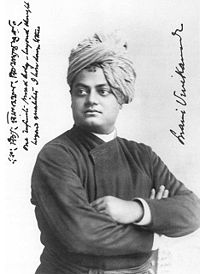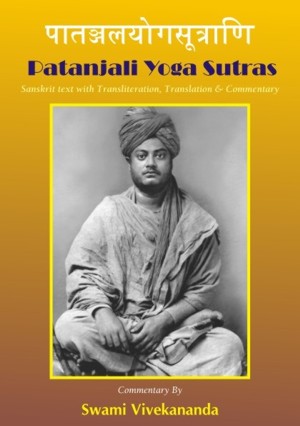25. तदभाबात्संयोगाभावो हानं तद्दृशेः कैवल्यम् ॥२५॥
tad-abhābāt-saṁyoga-abhāvo hānaṁ taddṛśeḥ kaivalyam ||25||
There being absence of that (ignorance) there is absence of junction, which is the thing-to-be-avoided; that is the independence of the seer.
According to this Yoga philosophy it is through ignorance that the Soul has been joined with nature and the idea is to get rid of nature’s control over us. That is the goal of all religions.
Each Soul is potentially divine. The goal is to manifest this Divinity within, by controlling nature, external and internal. Do this either by work, or worship, or psychic control, or by philosophy, by one, or more, or all of these - and be free. This is the whole of religion. Doctrines, or dogmas, or rituals, or books, or temples, or forms, are but secondary details. The Yogi tries to reach this goal through psychic control. Until we can free ourselves from nature we are slaves; as she dictates so we must go. The Yogi claims that he who controls mind controls matter also. The internal nature is much higher that the external, and much more difficult to grapple with, much more difficult to control; therefore he who has conquered the internal nature controls the whole universe; it becomes his servant. Raja Yoga propounds the methods of gaining this control. Higher forces than we know in physical nature will have to be subdued. This body is just the external crust of the mind. They are not two different things; they are just as the oyster and its shell. They are but two aspects of one thing; the internal substance of the oyster is taking up matter from outside, and manufacturing the shell. In the same way these internal fine forces which are called mind take up gross matter from outside, and from that manufacture this external shell, or body. If then, we have control of the internal, it is very easy to have control of the external. Then again, these forces are not different. It is not that some forces are physical, and some mental; the physical forces are but the gross manifestations of the fine forces, just as the physical world is but the gross manifestation of the fine world.
26. विवेकख्यातिरविप्लवा हानोपायः ॥२६॥
viveka-khyātir-aviplavā hānopāyaḥ ||26||
The means of destruction of ignorance is unbroken practice of discrimination.
This is the real goal of practice - discrimination between the real and unreal, knowing that the Purusa is not nature, that it is neither matter nor mind, and that because it is not nature, it cannot possibly change. It is only nature which changes, combining, and recombining, dissolving continually. When through constant practice we begin to discriminate, ignorance will vanish, and the Purusa will begin to shine in its real nature, omniscient, omnipotent, omnipresent.
27. तस्य सप्तधा प्रान्तभूमिः प्रज्ञ ॥२७॥
tasya saptadhā prānta-bhūmiḥ prajña ||27||
His knowledge is of the sevenfold highest ground.
When this knowledge comes, it will come, as it were, in seven grades, one after the other, and when one of these has begun we may know that we are getting knowledge. The first to appear will be that we have known what is to be known. The mind will cease to be dissatisfied. While we are aware of thirsting after knowledge we begin to seek here and there, wherever we think we can get some truth, and, failing to find it we become dissatisfied and seek in a fresh direction. All search is vain, until we begin to perceive that knowledge is within ourselves, that no one can help us, that we must help ourselves. When we begin to practice the power of discrimination, the first sign that we are getting near truth will be that that dissatisfied state will vanish. We shall feel quite sure that we have found the truth, and that it cannot be anything else but the truth. Then we may know that the sun is rising, that the morning is breaking for us, and, taking courage, we must persevere until the goal is reached. The second grade will be that all pains will be gone. It will be impossible for anything in the universe, physical, mental, or spiritual, to give us pain. The third will be that we shall get full knowledge, that omniscience will be ours. Next will come what is called freedom of the Chitta. We shall realise that all these difficulties and struggles have fallen off from us. All these vacillations of the mind, when the mind cannot be controlled, have falled down, just as a stone falls from the mountain top into the valley and never comes up again. The next will be that this Chitta itself will realise that it melts away into its causes whenever we so desire. Lastly we shall find that we are established in our Self, that we have been alone throughout the universe, neither body nor mind was ever connected with us, much less joined to us. They were working their own way, and we, through ignorance, joined ourselves to them. But we have been alone, omnipotent, omnipresent, ever blessed; our own Self was so pure and perfect that we required none else. We required none else to make us happy, for we are happiness itself. We shall find that this knowledge does not depend on anything else; throughout the universe there can be nothing that will not become effulgent before our knowledge. This will be the last state, and the Yogi will become peaceful and calm, never to feel any more pain, never to be again deluded, never to touch misery. He knows he is ever blessed, ever perfect, almighty.
28. योगाङ्गानुष्ठानादशुद्धिक्षये ज्ञानदीप्तिराविवेकख्यातेः ॥२८॥
yoga-aṅga-anuṣṭhānād-aśuddhi-kṣaye jñāna-dīptir-āviveka-khyāteḥ ||28||
By the practice of the different parts of Yoga the impurities being destroyed knowledge becomes effulgent, up to discrimination.
Now comes the practical knowledge. What we have just been speaking about is much higher. It is way above our heads, but it is the ideal. It is first necessary to obtain physical and mental control. Then the realisation will become steady in that ideal. The ideal being known, what remains is to practise the method of reaching it.
29. यम नियमासन प्राणायाम प्रत्याहार धारणा ध्यान समाधयोऽष्टावङ्गानि ॥२९॥
yama niyama-āsana prāṇāyāma pratyāhāra dhāraṇā dhyāna samādhayo-'ṣṭāvaṅgāni ||29||
Yama, Niyama, Asana, Pranayama, Pratya hara, Dharana, Dhyana, Samadhi, are the limbs of Yoga.
 Swami Vivekananda
Swami Vivekananda
